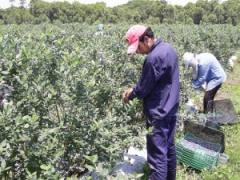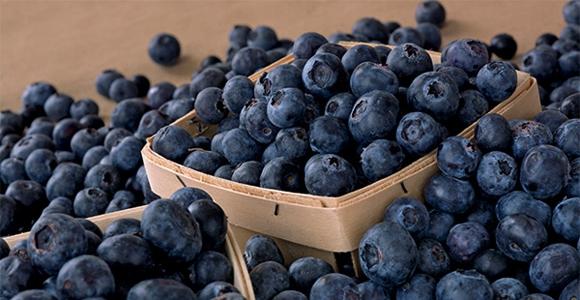

The articles listed in this category are for commercial blueberry growers
interested in using conventional methods.
- Blueberry Economics
- Blueberry Fertilizing
- Blueberry Freeze Damage and Protection Measures
- Blueberry Pest Management
- Blueberry Harvest
- Blueberry Pollination
- Blueberry Propagation
- Blueberry Soil Tests
- Blueberry Varieties
- Blueberry Commercial Conventional General Production Articles
Blueberry Economics: The Costs of Establishing and Producing Blueberries in the Willamette Valley
The 2011 Blueberry Economics publication released by authors James Julian, Bernadine Strik, and Wei Yang provides expert analysis of the costs facing Oregon growers for a newly established 20-acre blueberry planting following best management practices. Providing a set of critical assumptions underlying the analysis, the authors present both cash costs and returns and economic costs and returns at Years 0 through Years 6 of production, and full production under both machine and hand harvesting conditions.
Economic Analysis of Producing Southern Highbush Blueberries
Blueberries are a fast-emerging crop with a bright future; however, blueberries, just as other fruits, experience price fluctuations. This price volatility depends on several factors, including the variety produced and sold, locality, aggregate productivity, targeted market and timing.
Estimated Cost and Economics for Rabbiteye Blueberries
Rabbiteye blueberry (Vaccinium ashei) is the most important type of blueberry grown in Georgia. Rabbiteye blueberries are relatively high yielding with well-tended field commercial yields in the range of 5,000 to 8,000 pounds/acre typical on well-maintained fields. Fields may remain productive for 30 years or more.
Planning Budgets for Blueberry Production
This report is designed to provide planning data to farmers, research and extension staffs, lending agencies, and other people in agriculture.
Blueberries may be marketed at roadside stands, at pick-your-own operations, at on-farm sales or at farmer’s markets. There also are well-established wholesale markets for both fresh and frozen blueberries.
Blueberry growers who plan to buy plants from nurseries should arrive with a list of questions to ask. This article contains a few questions to help you get started.
Amount of Liquid Nitrogen for Blueberry Fertilization (Table)
Gives information about how much nitrogen to apply to blueberry crops per acre, both annually and weekly.
Fertilizer is usually applied to blueberries in the spring when growth begins and immediately after harvest. The exception to this is when the fertilizer is injected into the irrigation system, in which case, it is done on a weekly basis during the growing season (except during harvest).
Gives information about how much fertilizer to apply to blueberry crops based on age of plant.
Fertilizer may be applied in liquid form through the irrigation system rather than surface applying dry granular material. This process is known as “fertigation.”
Organic Matter Additions for Blueberries
Blueberries require soil with a pH of 4.5 to 5.5. For soils that typically have a low organic matter content, incorporating peat moss or well-decayed pine sawdust or bark will improve plant survival and growth.
Soil pH for Blueberry Plantings
Blueberries require a lower pH than many other fruit and vegetable crops. Before planting blueberries, test the soil to determine the pH level, as well as amounts of nitrogen, phosphorus, potassium and organic matter present.
Blueberry Freeze Damage and Protection Measures
Blueberry Freeze Damage and Protection Measures
Commercial blueberries are generally planted in low areas with high organic-matter content. These sites satisfy the cultural requirements of blueberries for a constant and uniform moisture supply.
Small Fruit Freeze Protection Passive or Alternate Methods
This course covers: winter freeze dangers, species sensitivity, methods of protection, spring frost and freeze dangers,as well as methods of protection to use for protecting blueberry crops from freeze damages.
Frost and Freeze Protection for Blueberries
Most rabbiteye blueberry varieties require 400 chill hours to 600 chill hours (hours below 45 F) to break dormancy. Until the cold requirement is achieved, an extended period of warm weather usually will not cause floral budbreak.
Blueberry Disease Management
Blueberry Insect Management
Blueberry Weed Management
Postharvest Cooling and Handling of Blueberries
Blueberries are a popular early summer small fruit. Successful blueberry marketing requires that the fruit not only be of very high quality but that it also be properly packaged and thoroughly cooled.
Bees, Blueberries and Pollination (Video)
Bob Danka for the USDA/ARS explains the importance of bees for blueberry pollination.
Blueberries usually are propagated from softwood or hardwood cuttings by cutting selected twigs from healthy, disease-free mother plants. Cuttings are placed in propagation beds in a medium that holds moisture well but also allows adequate aeration.
Collecting a Soil Sample (Video)
Do you know what chemicals or treatments are best for getting your garden or lawn ready for the growing season? In this YouTube video, Julie Treat, horticulturist with the Arkansas Cooperative Extension Service, shows the proper method for collecting a soil sample.
Instructions for Taking a Soil Test
To get a representative soil sample, follow the steps given in this article.
Soils and Composting: Soil Testing
Plants differ with respect to their soil pH and nutrient needs. Soils vary considerably in their capability to meet a plant’s nutritional needs depending on factors such as soil parent material, soil texture and structure, the amount of organic matter, biological activities, regional climate, and current growing conditions. Taking a soil test and using the recommendations that come with it will help plants receive adequate amounts of nutrients needed for plant growth.
Having soil tests performed by professionals in legitimate laboratories is important for blueberry producers, as producers of other crops. In Guidelines for Choosing a Soil Analytical Laboratory, researchers at the Ohio State University Cooperative Extension Service list considerations one should make when trying to decide where to send soil samples.
Knowing the type and amount of nutrients in your soil, could save you, as a blueberry producer, money. To do this, it is important to have your soil tested.
This variety is recommended for southern areas of Mississippi.
Blueberry Varieties: Rabbiteye
There are many varieties of rabbiteye blueberries. Planting two or more varieties for cross-pollination ensures fruit set and earlier ripening.
Blueberry Varieties: Southern Highbush
A new category of blueberries, Southern Highbush, has been developed for southern production. These varieties combine the late blooming date and shorter ripening period of the northern highbush and the low chill hours and adaptability to the southern environment of the rabbiteye.
The flesh of the ripe fruit is so firm it has been described as crunchy.
Medium-sized fruit with: good color, flavor, firmness, and small picking scar.
Mid- to Late-Season Blueberry Varieties
This article lists several blueberry varieties that produce mid- to late-season.
This variety blooms and ripens about the same time as the Biloxi variety in Mississippi.
This variety ripens late April to early May in Mississippi.
Recommended for planting in the upper part of the South because it requires a period of 800 to 1,000 chill hours.
Fruit is firm, medium-sized, good flavor, small scar, and somewhat darker than other cultivars.
Flowers later than rabbiteye and ripens late April in south Mississippi.
Fruit is large, firm with a good scar.
Fruit is large and easy to harvest because of a concentrated ripening period.
Fruit is firm with large and excellent color, flavor and picking scar.
Blueberry Commercial Conventional General Production Articles
Bare Root Blueberry Plants v. Container Blueberry Plants (Video)
David Himelrick of the LSU AgCenter explains the difference in obtaining and planting bare root blueberry plants and containerized blueberry plants.
In order to obtain a useful trait in a cultivated plant that may not exist in a species, or to enhance a desirable trait such as yield quality, a biotechnological approach that involves moving a gene from one organism into a crop plant is implemented.
Blueberry Phenology: Vegetative Growth
In blueberry plants, root and shoot growth occur in flushes throughout the growing season. Apparently, there is a cycling pattern between root and shoot growth during summer, but these cycles are not absolute.
How Many Blueberry Plants are Needed (Video)
Now that you’ve decided which blueberry varieties you want to plant, how many blueberry bushes should you order? David Himelrick of the LSU AgCenter says it’s a question of how much you like blueberries.
Mulching with organic materials, such as pine bark, pine needles, leaves, hay, wood chips, sawdust or other organic materials is very beneficial for soil health.
Plant More Than One Blueberry Variety (Video)
Which blueberry variety you should plant is the first thing to consider when planning to plant blueberry bushes. David Himelrick of the LSU AgCenter says it’s important to plant more than one variety to ensure cross pollination.
Plant the Proper Blueberry Variety (Video)
The type of blueberry bush you plant depends on where you live. David Himelrick from the LSU AgCenter discusses the four types of blueberry bushes: Wild or Lowbush Blueberries, Highbush Blueberries, Rabbiteye Blueberries and Southern Highbush Blueberries.
Principles of Pruning the Highbush Blueberry
Pruning a plant reduces its ultimate adult size and the crop yield in at least the following season. To compensate for this loss of bearing area and yield, other factors, largely economic, must be considered in planning a pruning program.
After establishment, rabbiteye blueberries require little pruning until they reach about 6 feet to 8 feet in height.
Site Selection for Blueberry Production
Site selection is crucial to the success of a blueberry planting. Soil properties (including fertility and terrain), climatic factors, and irrigation water quality must be considered when evaluating a site.
Soil Drainage and Irrigation for Blueberries
Utilizing proper soil drainage and irrigation techniques are important to growing healthy blueberry crops.
Experts tell us weed control is one of the greatest challenges when establishing a new blueberry planting.
World’s Blueberries Protected in Unique, Living Collection
Familiar blueberries and their lesser-known wild relatives are safeguarded by U.S. Department of Agriculture (USDA) scientists and curators at America’s official blueberry genebank.
Back to Blueberries Home.
